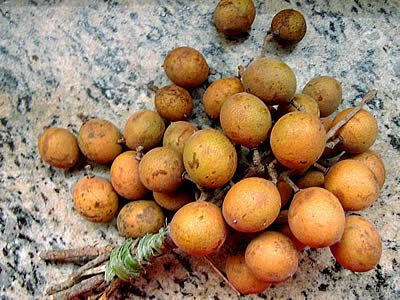The Pitomba Tree (Talisia esculenta) is a perennial, leafy, and fruitful species, still not widely cultivated but quite popular in the Northeast region of Brazil for its tasty fruits. The fruit of the pitomba tree, known as “pitomba,” derives its name from the Tupi language, meaning a slap or a strong kick. It belongs to the sapindaceae family, related to the exotic Lychee (Litchi chinensis) and Rambutan (Nephelium lappaceum).
It originates from the Amazon Basin and is naturally distributed in humid areas in the north and northeast of Brazil, as well as in Colombia, Peru, Paraguay and Bolivia, being common in floodplain areas. It should not be confused with the Bay Pitomba (Eugenia luschnathiana), which is a member of the Myrtaceae family. Of medium size, the pitomba tree reaches heights between 30 to 40 feet (9 to 12 meters), with a trunk approximately 16 inches (40 centimeters) in diameter and a rounded crown. Its leaves are alternate, pinnate, with two to four light green, glabrous, shiny, and elliptical leaflets.
The inflorescence is a thyrsus type, terminal, axillary, with tiny white to slightly orange flowers, but very fragrant. The fruiting season spans from January to April, often extending to June. The fruit appears in clusters and is an edible drupe, about 1 inch (2.5 cm) in diameter, oval to globular in shape, with a firm, thin, brownish, and powdery surface. It contains a translucent, juicy, sweet and sour pulp, with one to two elongated seeds. The fruits are also very attractive to wild birds.

Pitombas are usually consumed fresh (in natura), but they can also be used to make preserves, juices, desserts, liqueurs, and an excellent caipirinha. Rich in vitamin C, they possess high antioxidant properties. The tree is quite hardy and requires little care, making it an interesting option for home orchards. Moreover, being very attractive and providing food for wild birds, it becomes a chosen species for the reforestation of devastated areas.
It should be cultivated in full sun, in fertile, deep soil, enriched with organic matter, and watered regularly during the first years of establishment. A typically tropical tree, it prefers warm and humid climates for full development. Once well-established, it can tolerate short periods of drought.
The pitomba tree propagates through seeds. The ripe fruits should be completely depulped, and the clean seeds sown in sandy substrate, kept moist in a shaded area. Germination occurs in about 30 days. The plants begin producing approximately 3 years after planting. Mature trees can produce about 100 pounds (45 kilograms) of fruit annually.


